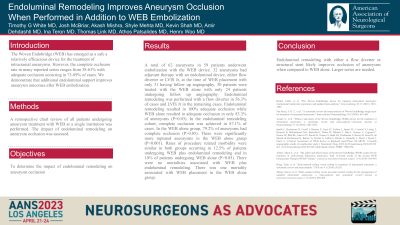Endoluminal Remodeling Improves Aneurysm Occlusion When Done in Addition to WEB Embolization
Friday, April 21, 2023


Timothy G. White, MD (he/him/his)
Resident
Donald and Barbara Zucker School of Medicine at Northwell Health
Manhasset, New York, United States
ePoster Presenter(s)
Introduction: The Woven Endobridge (WEB) has emerged as a safe a relatively efficacious device for the treatment of intracranial aneurysms. However, the complete occlusion rate in many reported series ranges from 50-70% with adequate occlusion occurring in 80-90% of cases. We demonstrate that additional endoluminal support improves aneurysm outcomes after WEB embolization.
Methods: A retrospective chart review of all patients undergoing aneurysm treatment with WEB at a single institution was done. The impact of endoluminal remodeling on aneurysm occlusion was assessed.
Results: A total of 62 aneurysms in 59 patients underwent embolization with the WEB device. 32 aneurysms had the addition of an endoluminal device, either flow diverter or LVIS Jr with only 31 having follow up angiography. 30 patients were treated with the WEB alone with only 24 patients undergoing follow up angiography. Endoluminal remodeling was done with a flow diverter in 56.3% of cases and LVIS Jr in the remaining cases. Endoluminal remodeling resulted in 100% adequate occlusion while WEB alone resulted in adequate occlusion in only 83.3% of aneurysms (P=0.03). In the endoluminal remodeling cohort, complete occlusion was achieved in 87.1% of cases. In the WEB alone group, 79.2% of aneurysms had complete occlusion (P>0.05). There were significantly more ruptured aneurysm in the WEB alone group (P < 0.001). Rates of procedure related morbidity were similar in both groups occurring in 12.5% of patients undergoing WEB plus endoluminal remodeling and in 10% of patients undergoing WEB alone (P>0.05). There were no mortalities associated with WEB plus endoluminal remodeling. There was one mortality associated with WEB placement in the WEB alone group.
Conclusion : Endoluminal remodeling either with a flow diverter or structural stent likely improves occlusion of aneurysms when compared to WEB alone. Larger series are needed.
Methods: A retrospective chart review of all patients undergoing aneurysm treatment with WEB at a single institution was done. The impact of endoluminal remodeling on aneurysm occlusion was assessed.
Results: A total of 62 aneurysms in 59 patients underwent embolization with the WEB device. 32 aneurysms had the addition of an endoluminal device, either flow diverter or LVIS Jr with only 31 having follow up angiography. 30 patients were treated with the WEB alone with only 24 patients undergoing follow up angiography. Endoluminal remodeling was done with a flow diverter in 56.3% of cases and LVIS Jr in the remaining cases. Endoluminal remodeling resulted in 100% adequate occlusion while WEB alone resulted in adequate occlusion in only 83.3% of aneurysms (P=0.03). In the endoluminal remodeling cohort, complete occlusion was achieved in 87.1% of cases. In the WEB alone group, 79.2% of aneurysms had complete occlusion (P>0.05). There were significantly more ruptured aneurysm in the WEB alone group (P < 0.001). Rates of procedure related morbidity were similar in both groups occurring in 12.5% of patients undergoing WEB plus endoluminal remodeling and in 10% of patients undergoing WEB alone (P>0.05). There were no mortalities associated with WEB plus endoluminal remodeling. There was one mortality associated with WEB placement in the WEB alone group.
Conclusion : Endoluminal remodeling either with a flow diverter or structural stent likely improves occlusion of aneurysms when compared to WEB alone. Larger series are needed.
